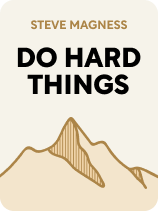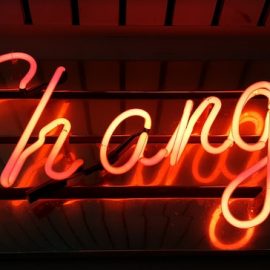

This article is an excerpt from the Shortform book guide to "Do Hard Things" by Steve Magness. Shortform has the world's best summaries and analyses of books you should be reading.
Like this article? Sign up for a free trial here.
What is the book Do Hard Things about? What are the main takeaways of the book?
In Do Hard Things, Steve Magness explores why traditional ideas around toughness are not only ineffective but harmful. He explains what it really means to be resilient with strategies on how to overcome discomfort and adversity.
Read below for a Do Hard Things book overview.
Do Hard Things by Steve Magness
The way we think about toughness, according to Steve Magness, is all wrong. We traditionally define toughness as a combination of machismo, lack of emotion, and outward displays of dominance and control. But Magness claims that this “old-school” definition of toughness is harmful and that real toughness is defined by confronting reality, acknowledging your thoughts, feelings, and emotions, and using a multitude of strategies to cope with discomfort or adversity. In his Do Hard Things book, Magness describes this new, more accurate, and more effective way of thinking about toughness, which will help you overcome challenges and make better, more thoughtful decisions.
An expert on performance and coaching, Magness has also written The Science of Running and co-authored Peak Performance and The Passion Paradox, and he argues that though we’ve come a long way, the “old-school” definition of toughness is still prevalent in our world, and this has negative consequences. It leads to an authoritarian style of coaching, teaching, parenting, and leadership whereby people tell you to toughen up, stop acting emotionally, or fight through pain in order to achieve your goals or be successful. But in the end, these tactics are harmful psychologically, don’t lead to well-rounded individuals, and simply aren’t effective in helping us overcome life’s challenges.
How We Misunderstand Toughness
Magness claims that the first step in becoming a truly tougher person is understanding what old-school toughness gets wrong. One of the significant problems with old-school toughness is the notion that you can tackle any challenge through sheer force of will. Though this may work sometimes, tackling problems this way will eventually cause most people to burn out or give up entirely. When facing a difficult challenge, instead of plowing ahead, it’s better to slow down, orient yourself, and make thoughtful decisions on how to best move forward. There’s more than one solution to your problems, and real toughness is about finding a solution any way you can, not pushing yourself past your limits.
The reason simply fighting through any challenge doesn’t work, according to Magness, is that eventually the stress of the fight will become too much, and you’ll give up. Therefore, Magness argues that the key to toughness is learning how to navigate the inner turmoil you experience when dealing with stress. The more stressful a situation, the more likely that the approach of fighting through the pain will eventually lead you to take the easy way out and listen to the part of you that wants to quit or panic. But if you can train yourself to slow down and recognize what’s happening within you, you can create enough space to make the best decision instead of the easiest one.
Strategy 1: Face Reality
Now that we understand what old-school toughness gets wrong, Magness explains his first step in becoming a tougher, more resilient person: facing reality. Facing the reality of a situation and the reality of your capabilities is an important first step because to make the best decisions when facing adversity, you need to accurately assess the problem and what you can do to solve it.
Strategy 2: Understand Your Emotions
Another key attribute of a truly tough person is the ability to understand your emotions. Magness claims that emotions protect us; they help us navigate the world. If you suppress your feelings and emotions, you’re suppressing your ability to navigate the world effectively. Old-school toughness tells you that you should listen to some emotions (like joy, pride, or anger) while ignoring others (like sadness or fear). Magness, however, claims that you should try to understand and interpret all of your feelings and emotions so that you can make better choices.
Feelings give us important information that we should listen to, claims Magness. Instead of viewing emotions as things that get in our way, as the old-school version of toughness might advise, we should listen and try to understand what our feelings and emotions are telling us. When you understand why you’re feeling a certain way, you can use that information to make better decisions.
In most cases, you’re perfectly capable of accurately assessing your feelings and what decisions you should make based on them—if you feel disgusted by the smell of a certain food, you don’t eat it, trusting your feelings to tell you that the food isn’t safe. But in times of stress or adversity, you more often misinterpret your emotions, which can lead to poor decision-making. For example, when you have a stressful day at work, you might be more irritable when you get home and get unreasonably angry at your loved ones.
To better understand your emotions, Magness recommends that you label them. Labeling or putting a name to your emotions is helpful because it helps you interpret them. When we put a name to an emotion, we focus our attention on it, which allows us to examine it more closely. This can help you avoid simply acting on the emotion because as you examine it, you can better understand why you’re acting a certain way. For example, if you had labeled your irritability after a long day at work, you might have been able to put some space between the irritability and the anger that followed and stopped yourself from getting angry at your partner.
Strategy 3: Listen to Your Inner Voices
Another key aspect of toughness, according to Magness, is learning how to interpret and deal with internal debates. When making a decision, we all have several “voices” in our heads pointing us to a certain behavior. In normal, everyday decisions, like deciding what to wear to work, these voices are calm and collected, helping us make a somewhat easy, unimportant choice. In challenging situations, however, ones that require toughness, there might be several voices competing loudly against each other, pushing you toward different behaviors. Navigating these loud voices and making a decision based on them is much more difficult.
Old-school toughness teaches you to simply ignore the voices that don’t align with your goals, like the voice telling you to give up. Magness writes that instead of ignoring these voices, we should acknowledge and respond to them, as when we consciously recognize our doubts, fears, or other emotions, we can make better decisions.
According to one school of thought, we developed inner voices as a way to deal with stress. They serve as a way of making our abstract feelings more tangible. When we address our feelings with our inner voices, we can think about them more concretely, which can help us turn feelings into the appropriate actions or inactions. In other words, while our feelings help us navigate the world, our inner voices and thoughts help us navigate our feelings. The key to toughness is learning how to use our inner voices to our benefit and not letting the negative voices win out and lead us to poor decisions.
According to Magness, there are three strategies we can use to make better use of our inner voices:
Vocalize your thoughts: Putting your thoughts into words can help you focus on the thought you want to be focused on. By vocalizing a thought, you give it more power. Also, since our inner dialogue is often convoluted, vocalizing your thoughts can simplify them and make them more actionable.
Don’t be overly positive: People often try to hype themselves up with positive internal dialogue. According to research, however, this only works if you actually believe what you’re saying to yourself. If you think to yourself, “I can do this,” you aren’t going to trick yourself into believing it. Even when talking to yourself, you have to be realistic.
Think in the second or third person: Magness notes that when we engage in internal dialogue, we often think in the first person—“I’ve got this” or “I’m capable.” But research shows that simply thinking “You got this” or “(your name) is capable” can improve your ability to perform. This is because thinking in the second or third person puts space between yourself and the situation, helping you consider it more objectively and make better decisions.
Strategy 4: Zoom In or Zoom Out
Magness states that true toughness is about learning to deal with pain or discomfort, whether it be mental, physical, or emotional. This means being flexible—broadening or narrowing your focus depending on the situation. Magness claims that the toughest people—those who can thrive in the face of adversity—know when to shift between a broad and narrow state of mind. On the other hand, the only strategy of old-school toughness is to fight against pain and push through. This approach focuses your attention only on the specific task you’re currently working on.
Sometimes, Magness points out, narrowing your focus is the best strategy. In times of stress, this is advantageous because it allows you to focus intensely on the task you need to accomplish. But, as we’ve discussed, most people can only do this for so long before their negative thoughts spiral and they give up, panic, or make poor decisions. When narrowing your focus is your only strategy, it limits your options—when your attempt doesn’t work the first time, your only option is to try again. You need to be able to try something different instead of doubling down and wasting your effort.
When narrowing your focus fails, when you feel on the verge of giving up or panicking, you must be able to zoom out and take on a new perspective. This approach allows you to take in more information, be more creative, and avoid the pitfalls of narrowing your attention. For instance, if you’re freaking out about an upcoming presentation, it may be better to zoom out and think about how unimportant your presentation is in the grand scheme of things rather than fixate on the presentation or your anxiety. The key, however, according to Magness, is learning when to broaden and narrow and being able to shift your focus and attention at will.
Let’s say you’re an ambulance driver trying to get a patient to the hospital as fast as you can. When everything is going according to plan, you can zoom in and focus on driving your chosen route as quickly and safely as possible. But if you hit an unexpected traffic jam, you need to zoom out, take in your surroundings, and come up with a new plan. Perhaps you realize you can cut through a parking lot, backtrack a few hundred meters, and take a side road that will get you to your destination quicker.
To improve your focusing abilities, Magness suggests the following exercises:
Narrow and broaden your thoughts: Think of a hypothetical problem—for example, say there’s too much vehicle traffic in your neighborhood, and you want to improve this. Now, think of the most obvious solution to this problem, and make a detailed plan on how you would implement it. Then, zoom out, and instead of coming up with one detailed plan, come up with as many solutions to the problem as you can think of, no matter how ridiculous or impractical they seem. This exercise is meant to improve your ability to solve problems in different ways—first by narrowing your attention and improving concentration, then by broadening it and improving creativity.
Zoom in and out visually: This exercise is meant to help you shift between a narrow and broad state of mind using visual cues. Direct your attention to a single object. Zoom in on this object, noticing as many details about it as you can. Then, zoom out, unfocusing your vision so that it’s blurry. Try to not focus on the details of any single object, but instead notice everything around you. You can also use this exercise in times of stress—if you feel yourself becoming overwhelmed by a situation, try to zoom out and broaden your vision to keep your negative thoughts from spiraling.

———End of Preview———
Like what you just read? Read the rest of the world's best book summary and analysis of Steve Magness's "Do Hard Things" at Shortform.
Here's what you'll find in our full Do Hard Things summary:
- Why the "old-school" way we think about toughness is wrong
- Why machismo ideals are harmful and ineffective
- How to become resilient and versatile, and how to overcome adversity






